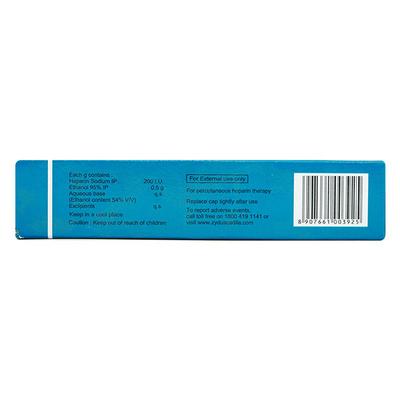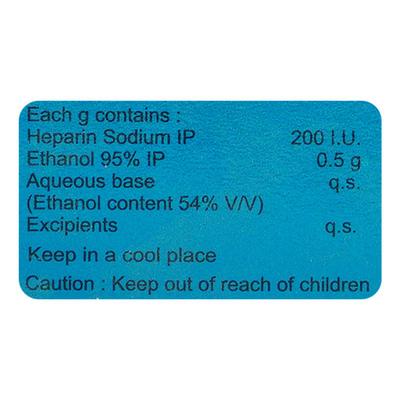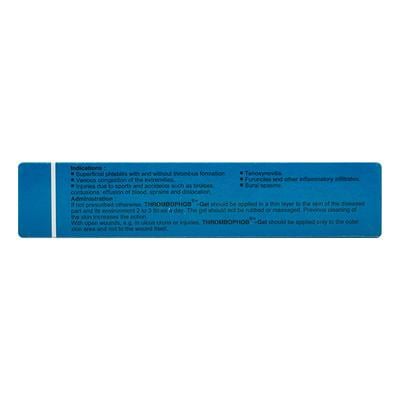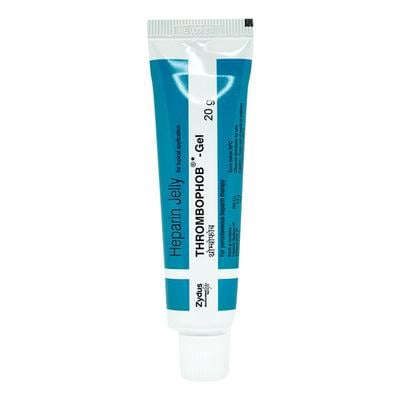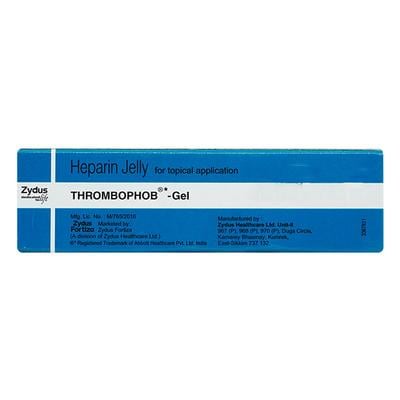

Netmeds First Membership
Quick Links
Introduction About THROMBOPHOB 2+50 GEL
Thrombophob Gel is an anticoagulant, used as a topical management for superficial phlebitis (inflamed vein (varicose vein)) with or without thrombus (blood clot) formation, venous congestion of the extremities, injuries from sports and accidents, including bruises, contusions, blood effusion, sprains and dislocations.
It is also used for tenosynovitis (inflammation of the synovial membrane), furuncles (painful reddish or purple bumps) and other inflammatory infiltrates, and sural spasms (pain in leg, foot and toes). It contains heparin sodium as an active ingredient which is used to manage clot formation.
Heparin is an anticoagulant that inhibits blood clotting by activating your body's anti-clotting processes. It also possesses anti-exudative and pain-relieving properties; thus, it relieves pain, reduces tension of vascular muscles and improves blood circulation.
Always use Thrombophob Gel as advised by your physician. Don't massage or rub the gel. In open wounds, e.g., in ulcus cruris or injuries. It should be applied only to the outer area of the skin and not to the wound itself.
Key Composition
- Heparin Sodium
Therapeutic Uses Of THROMBOPHOB 2+50 GEL
Used as a topical management for conditions such as:
- superficial phlebitis with or without blood clot formation
- venous congestion of the extremities (chronic venous insufficiency develops when the veins in legs manage blood from returning to heart)
- injuries from sports and accidents, including bruises, contusions, blood effusion, sprains, and dislocations
- tenosynovitis
- furuncles and other inflammatory infiltrates
- sural spasms
Side Effects Of THROMBOPHOB 2+50 GEL
Consult your doctor if you notice any unusual side effects while using Thrombophob Gel.
Safety Advice
- Always apply Thrombophob Gel as advised by your physician
- A thin layer of Thrombophob Gel should be applied to the skin of the affected area 2 to 3 times a day. Don't massage or rub the gel. Previous cleaning of the skin increases the action. In open wounds, e.g., in ulcus cruris or injuries
- Thrombophob Gel should be applied only to the outer area of the skin and not to the wound itself
- Do not use if you are allergic to any of its ingredients
- Ask your doctor before using Thrombophob Gel during pregnancy or breastfeeding
- Inform your doctor on all the medicines you use, including prescription and over-the counter medications, as well as herbal supplements
More Information
- Keep Thrombophob Gel out of reach and sight of children
- Store in a cool place
FAQs About THROMBOPHOB 2+50 GEL
Q: What is Thrombophob Gel used for?
A: Thrombophob Gel is an anticoagulant used to manage superficial phlebitis (inflamed vein (varicose vein)) with or without thrombus (blood clot) formation, venous congestion of the extremities, injuries from sports and accidents, including bruises, contusions, blood effusion, sprains, and dislocations. It is also used to manage tenosynovitis (inflammation of the synovial membrane), furuncles (painful reddish or purple bumps) and other inflammatory infiltrates, and sural spasms (pain in the legs, feet, and toes). It contains heparin sodium as an active ingredient, which is used to manage clot formation.
Q: Can we use Thrombophob Gel on open wounds?
A: In open wounds (Ex. ulcus cruris or injuries), Thrombophob Gel should be applied only to the outer area of the skin and not to the wound itself. Consult your doctor for advice.
Q: How do you use Thrombophob Gel?
A: Always apply Thrombophob Gel as advised by your physician. A thin layer of Thrombophob Gel should be applied to the skin of the affected area 2-3 times a day. Don't massage or rub the gel. Previous cleaning of the skin increases the action.
Q: What are the side effects of Thrombophob Gel?
A: It is not known to cause any side effects when used as advised, however, consult your doctor if you notice any unusual side effects while applying Thrombophob Gel.
Q: How does Thrombophob Gel work?
A: Thrombophob Gel contains heparin, which inhibits blood clotting by activating your body's anti-clotting processes. It also possesses anti-exudative and pain-relieving properties; thus, it relieves pain, reduces tension in vascular muscles, and improves blood circulation.
Q: How long can Thrombophob Gel be used?
A: The duration of management with Thrombophob Gel depends on the condition being managed and the response to therapy. It's important to follow the management plan prescribed by your healthcare provider and to discontinue use if there is no improvement or if any adverse reactions occur.
Q: Can Thrombophob Gel be used for haemorrhoids (piles)?
A: Thrombophob Gel is not commonly used for the management of haemorrhoids. Haemorrhoids have different underlying causes and managements, and using Thrombophob Gel may not provide adequate relief. It's best to consult a healthcare provider for appropriate management of haemorrhoids.
Q: Who should not use Thrombophob Gel?
A: Do not use Thrombophob Gel if you are allergic to heparin sodium or any of the other ingredients in this medicine.
Q: Can Thrombophob Gel be used on the face?
A: Thrombophob Gel is not recommended for use on the face unless specifically instructed by a healthcare provider. It is typically intended for application on the body, specifically on areas affected by superficial thrombophlebitis or bruises.
Q: Is Thrombophob Gel safe during pregnancy?
A: There is no information on the use of Thrombophob Gel in pregnant women. Inform your doctor if you are pregnant or planning to become pregnant before using it.
Q: Can I use Thrombophob Gel in children?
A: Thrombophob Gel is not recommended for use in children and adolescents below 18 years of age as safety and effectiveness have not been established yet. Consult with your child’s doctor before using Thrombophob Gel for your child.
Q: Can Thrombophob Gel be used for muscle pain or arthritis?
A: Thrombophob Gel is not indicated for the management of muscle pain or arthritis. It is primarily used for conditions involving blood clotting and inflammation, such as superficial thrombophlebitis and bruises. Other medications may be more suitable for managing muscle pain or arthritis, and it's important to consult a healthcare provider for appropriate management options.
References
- https://go.drugbank.com/drugs/DB01109









